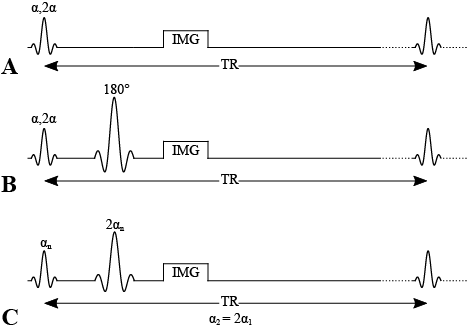Double Angle method(s)
Double Angle technique
The Double Angle method (DA or DAM) is a class of B1 mapping technique swherein two RF pulses at flip angles α and 2α are applied to a pulse sequence, and the ratio of the images are compared to expected output to produce a B1 map. Several main pulse sequences (Figure 4.1]) have been called the double angle method in the literature, and both have their own equations describing the relationship between the expected images and B1. In this chapter, we’ll mostly explore there the α-180 method (Figure 4.1]), and then briefly explain the other method and its similarities/differences.

Figure 4.1:Pulse sequences for double angle methods. A) Double angle method using a gradiend echo. B) Double angle method using a 180 degree refocusing pulse. C) Double angle method using a refocusing pulse, acquired with two values and such that .